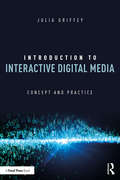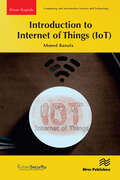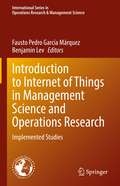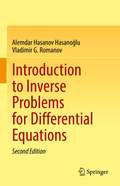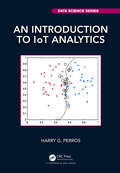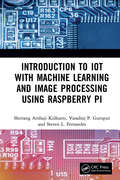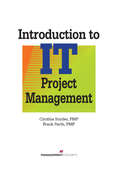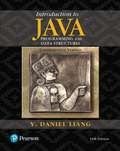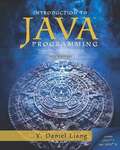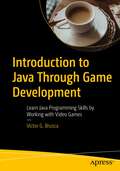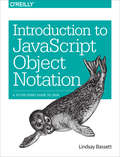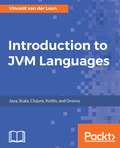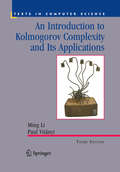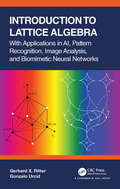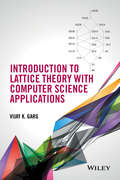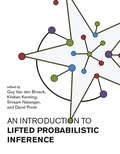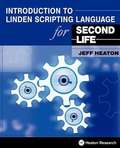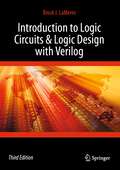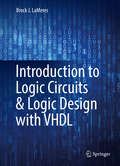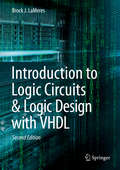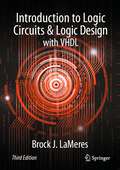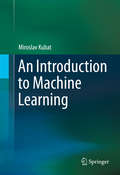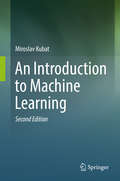- Table View
- List View
Introduction to Interactive Digital Media: Concept and Practice
by Julia V. GriffeyThis book offers a clearly written and engaging introduction to the basics of interactive digital media. As our reliance on and daily usage of websites, mobile apps, kiosks, games, VR/AR and devices that respond to our commands has increased, the need for practitioners who understand these technologies is growing. Author Julia Griffey provides a valuable guide to the fundamentals of this field, offering best practices and common pitfalls throughout. The book also notes opportunities within the field of interactive digital media for professionals with different types of skills, and interviews with experienced practitioners offer practical wisdom for readers. Additional features of this book include: An overview of the history, evolution and impact of interactive media; A spotlight on the development process and contributing team members; Analysis of the components of interactive digital media and their design function (graphics, animation, audio, video, typography, color); An introduction to coding languages for interactive media; and A guide to usability in interactive media. Introduction to Interactive Digital Media will help both students and professionals understand the varied creative, technical, and collaborative skills needed in this exciting and emerging field.
Introduction to Internet of Things (River Publishers Series in Rapids in Computing and Information Science and Technology)
by Ahmed BanafaThis book introduces the Internet of Things (IoT), which is the convergence of connecting people, things, data and processes; it is transforming our life, business and everything in between. By 2025, experts forecast that up to 75 billion devices will be connected to the Internet with only one third of them being computers, smartphones, smartwatches, and tablets. The remaining two thirds will be other "devices" – sensors, terminals, household appliances, thermostats, televisions, automobiles, production machinery, urban infrastructure and many other "things", which traditionally have not been Internet enabled. This "Internet of Things" (IoT) represents a remarkable transformation of the way in which our world will soon interact. Much like the World Wide Web connected computers to networks, and the next evolution mobile devices connected people to the Internet and other people, IoT looks poised to interconnect devices, people, environments, virtual objects and machines in ways that only science fiction writers could have imagined.
Introduction to Internet of Things in Management Science and Operations Research: Implemented Studies (International Series in Operations Research & Management Science #311)
by Fausto Pedro García Márquez Benjamin LevThis book aims to provide relevant theoretical frameworks and the latest empirical research findings in Internet of Things (IoT) in Management Science and Operations Research. It starts with basic concept and present cases, applications, theory, and potential future. The contributed chapters to the book cover wide array of topics as space permits. Examples are from smart industry; city; transportation; home and smart devices. They present future applications, trends, and potential future of this new discipline. Specifically, this book provides an interface between the main disciplines of engineering/technology and the organizational, administrative, and planning capabilities of managing IoT. This book deals with the implementation of latest IoT research findings in practice at the global economy level, at networks and organizations, at teams and work groups and, finally, IoT at the level of players in the networked environments. This book is intended for professionals in the field of engineering, information science, mathematics, economics, and researchers who wish to develop new skills in IoT, or who employ the IoT discipline as part of their work. It will improve their understanding of the strategic role of IoT at various levels of the information and knowledge organization. The book is complemented by a second volume of the same editors with practical cases.
Introduction to Inverse Problems for Differential Equations
by Alemdar Hasanov Hasanoğlu Vladimir G. RomanovThis book presents a systematic exposition of the main ideas and methods in treating inverse problems for PDEs arising in basic mathematical models, though it makes no claim to being exhaustive. Mathematical models of most physical phenomena are governed by initial and boundary value problems for PDEs, and inverse problems governed by these equations arise naturally in nearly all branches of science and engineering.The book’s content, especially in the Introduction and Part I, is self-contained and is intended to also be accessible for beginning graduate students, whose mathematical background includes only basic courses in advanced calculus, PDEs and functional analysis. Further, the book can be used as the backbone for a lecture course on inverse and ill-posed problems for partial differential equations.In turn, the second part of the book consists of six nearly-independent chapters. The choice of these chapters was motivated by the fact that the inverse coefficient and source problems considered here are based on the basic and commonly used mathematical models governed by PDEs. These chapters describe not only these inverse problems, but also main inversion methods and techniques. Since the most distinctive features of any inverse problems related to PDEs are hidden in the properties of the corresponding solutions to direct problems, special attention is paid to the investigation of these properties.For the second edition, the authors have added two new chapters focusing on real-world applications of inverse problems arising in wave and vibration phenomena. They have also revised the whole text of the first edition.
An Introduction to IoT Analytics (Chapman & Hall/CRC Data Science Series)
by Harry G. PerrosThis book covers techniques that can be used to analyze data from IoT sensors and addresses questions regarding the performance of an IoT system. It strikes a balance between practice and theory so one can learn how to apply these tools in practice with a good understanding of their inner workings. This is an introductory book for readers who have no familiarity with these techniques. The techniques presented in An Introduction to IoT Analytics come from the areas of machine learning, statistics, and operations research. Machine learning techniques are described that can be used to analyze IoT data generated from sensors for clustering, classification, and regression. The statistical techniques described can be used to carry out regression and forecasting of IoT sensor data and dimensionality reduction of data sets. Operations research is concerned with the performance of an IoT system by constructing a model of the system under study and then carrying out a what-if analysis. The book also describes simulation techniques. Key Features IoT analytics is not just machine learning but also involves other tools, such as forecasting and simulation techniques. Many diagrams and examples are given throughout the book to fully explain the material presented. Each chapter concludes with a project designed to help readers better understand the techniques described. The material in this book has been class tested over several semesters. Practice exercises are included with solutions provided online at www.routledge.com/9780367686314 Harry G. Perros is a Professor of Computer Science at North Carolina State University, an Alumni Distinguished Graduate Professor, and an IEEE Fellow. He has published extensively in the area of performance modeling of computer and communication systems.
Introduction to IoT with Machine Learning and Image Processing using Raspberry Pi
by Shrirang Ambaji Kulkarni Varadrah P. Gurupur Steven L. FernandesMachine Learning a branch of Artificial Intelligence is influencing the society, industry and academia at large. The adaptability of Python programming language to Machine Learning has increased its popularity further. Another technology on the horizon is Internet of Things (IoT). The present book tries to address IoT, Python and Machine Learning along with a small introduction to Image Processing. If you are a novice programmer or have just started exploring IoT or Machine Learning with Python, then this book is for you. Features: Raspberry Pi as IoT is described along with the procedure for installation and configuration. A simple introduction to Python Programming Language along with its popular library packages like NumPy, Pandas, SciPy and Matplotlib are dealt in an exhaustive manner along with relevant examples. Machine Learning along with Python Scikit-Learn library is explained to audience with an emphasis on supervised learning and classification. Image processing on IoT is introduced to the audience who love to apply Machine Learning algorithms to Images The book follows hands-on approach and provide a huge collection of Python programs.
Introduction to IT Project Management
by Cynthia Snyder Pmp Frank Parth PmpIntroduction to IT Project Management provides IT project managers the practical tools needed to maintain daily operations while managing multiple projects. This valuable reference helps IT project managers, CIOs, and project sponsors understand the IT project environment so that projects can be managed much more efficiently and successfully. An instructor's guide is available.
Introduction To Java Programming And Data Structures: Comprehensive Version
by Y. Daniel LiangThis text is intended for a 1-semester CS1 course sequence. The Brief Version contains the first 18 chapters of the Comprehensive Version. The first 13 chapters are appropriate for preparing the AP Computer Science exam. Coverage of Java and programming make this a useful reference for beginning programmers and IT professionals. Daniel Liang teaches concepts of problem-solving and object-oriented programming using a fundamentals-first approach. Beginning programmers learn critical problem-solving techniques then move on to grasp the key concepts of object-oriented, GUI programming, advanced GUI and Web programming using Java. Liang approaches Java GUI programming using JavaFX, not only because JavaFX is much simpler for new Java programmers to learn and use but because it has replaced Swing as the new GUI tool for developing cross-platform-rich Internet applications on desktop computers, on hand-held devices, and on the Web. Additionally, for instructors, JavaFXprovides a better teaching tool for demonstrating object-oriented programming.
Introduction to Java Programming, Comprehensive Version
by Y. Daniel LiangThis text is intended for a 1-, 2-, or 3-semester CS1 course sequence. Comprehensive coverage of Java and programming make this a useful reference for beginning programmers and IT professionals. Daniel Liang teaches concepts of problem-solving and object-oriented programming using a fundamentals-first approach. Beginning programmers learn critical problem-solving techniques then move on to grasp the key concepts of object-oriented, GUI programming, advanced GUI and Web programming using Java. Liang approaches Java GUI programming using JavaFX, not only because JavaFX is much simpler for new Java programmers to learn and use but because it has replaced Swing as the new GUI tool for developing cross-platform-rich Internet applications on desktop computers, on hand-held devices, and on the Web.
Introduction to Java Through Game Development: Learn Java Programming Skills by Working with Video Games
by Victor G. BruscaInterested in learning how to program with Java? Let’s face it, the best way to learn to program is by writing programs. This can be a daunting proposition with the specter of hours of simple command line example programs hanging over your head. Fear not! Now you can learn to program in Java in a fun way by working on video games. With this book, you’ll get to work with three Java game projects and have access to the complete game code for each project, including a full Java game engine. After completing Introduction to Java through Game Development, you’ll be proficient in Java programming, having worked with the language’s fundamental aspects throughout the text, and will be ready to further your Java and game programming expertise with confidence.What You'llMaster the fundamentals of the Java programming languageUse different data structures like arrays, lists, stacks, and queuesUnderstand game programming basics including the main game loopGain experience working with three different game projects via the book’s coding challengesWork with the 2D game engine that powers the book's included games and learn to create your own new game projectsUnderstand advanced Java topics like classes, encapsulation, inheritance, and polymorphismWork with exceptions and how to use debugging techniques to trace through codeSharpen your skills with over a dozen coding challenges that test your abilities with a development task on a real game projectWho This Book Is ForThis book requires little to no programming experience to understand and benefit from the text.
Introduction to JavaScript Object Notation
by Lindsay BassettWhat is JavaScript Object Notation (JSON) and how can you put it to work? This concise guide helps busy IT professionals get up and running quickly with this popular data interchange format, and provides a deep understanding of how JSON works. <P><P>Author Lindsay Bassett begins with an overview of JSON syntax, data types, formatting, and security concerns before exploring the many ways you can apply JSON today.From Web APIs and server-side language libraries to NoSQL databases and client-side frameworks, JSON has emerged as a viable alternative to XML for exchanging data between different platforms. If you have some programming experience and understand HTML and JavaScript, this is your book.Learn why JSON syntax represents data in name-value pairsExplore JSON data types, including object, string, number, and arrayFind out how you can combat common security concernsLearn how the JSON schema verifies that data is formatted correctlyExamine the relationship between browsers, web APIs, and JSONUnderstand how web servers can both request and create dataDiscover how jQuery and other client-side frameworks use JSONLearn why the CouchDB NoSQL database uses JSON to store data
Introduction to JVM Languages
by Vincent Van LeunExplore the Java Virtual Machine with modern programming languages About This Book • This guide provides in-depth coverage of the Java Virtual Machine and its features • Filled with practical examples, this book will help you understand the core concepts of Java, Scala, Clojure, Kotlin, and Groovy • Work with various programming paradigms and gain knowledge about imperative, object-oriented and functional programming Who This Book Is For This book is meant for programmers who are interested in the Java Virtual Machine (JVM) and want to learn more about the most popular programming languages that can be used for JVM development. Basic practical knowledge of a modern programming language that supports object-oriented programming (JavaScript, Python, C#, VB.NET, and C++) is assumed. What You Will Learn • Gain practical information about the Java Virtual Machine • Understand the popular JVM languages and the Java Class Library • Get to know about various programming paradigms such as imperative, object-oriented, and functional • Work with common JVM tools such as Eclipse IDE, Gradle, and Maven • Explore frameworks such as SparkJava, Vert.x, Akka and JavaFX • Boost your knowledge about dialects of other well-known programming languages that run on the JVM, including JavaScript, Python, and Ruby In Detail Anyone who knows software development knows about the Java Virtual Machine. The Java Virtual Machine is responsible for interpreting Java byte code and translating it into actions. In the beginning, Java was the only programming language used for the JVM. But increasing complexity of the language and the remarkable performance of the JVM created an opening for a new generation of programming languages. If you want to build a strong foundation with the Java Virtual Machine and get started with popular modern programming languages, then this book is for you. The book will begin with a general introduction of the JVM and its features, which are common to the JVM languages, helping you get abreast with its concepts. It will then dive into explaining languages such as Java, Scala, Clojure, Kotlin, and Groovy and will show how to work with each language, their features, use cases, and pros and cons. By writing example projects in those languages and focusing on each language's strong points, it will help you find the programming language that is most appropriate for your particular needs. By the end of the book, you will have written multiple programs that run on the Java Virtual Machine and know about the differences between the various languages. Style and approach This practical, example-filled guide will help you get started with the JVM and some of its most popular languages.
An Introduction to Kolmogorov Complexity and Its Applications (Texts in Computer Science)
by Ming Li Paul M. B. Vitányi"The book is outstanding and admirable in many respects. ... is necessary reading for all kinds of readers from undergraduate students to top authorities in the field." Journal of Symbolic Logic Written by two experts in the field, this is the only comprehensive and unified treatment of the central ideas and applications of Kolmogorov complexity. The book presents a thorough treatment of the subject with a wide range of illustrative applications. Such applications include the randomness of finite objects or infinite sequences, Martin-Loef tests for randomness, information theory, computational learning theory, the complexity of algorithms, and the thermodynamics of computing. It will be ideal for advanced undergraduate students, graduate students, and researchers in computer science, mathematics, cognitive sciences, philosophy, artificial intelligence, statistics, and physics. The book is self-contained in that it contains the basic requirements from mathematics and computer science. Included are also numerous problem sets, comments, source references, and hints to solutions of problems. New topics in this edition include Omega numbers, Kolmogorov-Loveland randomness, universal learning, communication complexity, Kolmogorov's random graphs, time-limited universal distribution, Shannon information and others.
Introduction to Lattice Algebra: With Applications in AI, Pattern Recognition, Image Analysis, and Biomimetic Neural Networks
by Gerhard X. Ritter Gonzalo UrcidLattice theory extends into virtually every branch of mathematics, ranging from measure theory and convex geometry to probability theory and topology. A more recent development has been the rapid escalation of employing lattice theory for various applications outside the domain of pure mathematics. These applications range from electronic communication theory and gate array devices that implement Boolean logic to artificial intelligence and computer science in general. Introduction to Lattice Algebra: With Applications in AI, Pattern Recognition, Image Analysis, and Biomimetic Neural Networks lays emphasis on two subjects, the first being lattice algebra and the second the practical applications of that algebra. This textbook is intended to be used for a special topics course in artificial intelligence with a focus on pattern recognition, multispectral image analysis, and biomimetic artificial neural networks. The book is self-contained and – depending on the student’s major – can be used for a senior undergraduate level or first-year graduate level course. The book is also an ideal self-study guide for researchers and professionals in the above-mentioned disciplines. Features Filled with instructive examples and exercises to help build understanding Suitable for researchers, professionals and students, both in mathematics and computer science Every chapter consists of exercises with solution provided online at www.Routledge.com/9780367720292
Introduction to Lattice Theory with Computer Science Applications
by Vijay K. GargA computational perspective on partial order and lattice theory, focusing on algorithms and their applications This book provides a uniform treatment of the theory and applications of lattice theory. The applications covered include tracking dependency in distributed systems, combinatorics, detecting global predicates in distributed systems, set families, and integer partitions. The book presents algorithmic proofs of theorems whenever possible. These proofs are written in the calculational style advocated by Dijkstra, with arguments explicitly spelled out step by step. The author's intent is for readers to learn not only the proofs, but the heuristics that guide said proofs. Introduction to Lattice Theory with Computer Science Applications: Examines; posets, Dilworth's theorem, merging algorithms, lattices, lattice completion, morphisms, modular and distributive lattices, slicing, interval orders, tractable posets, lattice enumeration algorithms, and dimension theory Provides end of chapter exercises to help readers retain newfound knowledge on each subject Includes supplementary material at www.ece.utexas.edu/~garg Introduction to Lattice Theory with Computer Science Applications is written for students of computer science, as well as practicing mathematicians.
An Introduction to Lifted Probabilistic Inference (Neural Information Processing series)
by David PooleRecent advances in the area of lifted inference, which exploits the structure inherent in relational probabilistic models.Statistical relational AI (StaRAI) studies the integration of reasoning under uncertainty with reasoning about individuals and relations. The representations used are often called relational probabilistic models. Lifted inference is about how to exploit the structure inherent in relational probabilistic models, either in the way they are expressed or by extracting structure from observations. This book covers recent significant advances in the area of lifted inference, providing a unifying introduction to this very active field. After providing necessary background on probabilistic graphical models, relational probabilistic models, and learning inside these models, the book turns to lifted inference, first covering exact inference and then approximate inference. In addition, the book considers the theory of liftability and acting in relational domains, which allows the connection of learning and reasoning in relational domains.
Introduction to Linden Scripting Language for Second Life
by Jeff HeatonThe Linden Scripting Language allows residents of the Second Life World to program the three dimensional objects around them. Without this programming objects built in Second Life are motionless and non-interactive. Adding a script enables an object to interact with the world around it. Second Life scripts allow objects such as cars, planes, amusement park rides, weapons and other entertainment devices to be created. This book teaches the beginning Second Life programmer to make use of the basics of the Linden Scripting Language. Language fundamentals, such as variables, loops, lists, events, functions and state machines are covered. The book then moves to more advanced topics such as user interaction and non-physical movement. Later chapters show how to use the Second Life physics engine to create vehicles.
Introduction To Linear Algebra: Computation, Application, and Theory (Textbooks in Mathematics)
by Mark J. DeBonisIntroduction to Linear Algebra: Computation, Application, and Theory is designed for students who have never been exposed to the topics in a linear algebra course. The text is filled with interesting and diverse application sections but is also a theoretical text which aims to train students to do succinct computation in a knowledgeable way. After completing the course with this text, the student will not only know the best and shortest way to do linear algebraic computations but will also know why such computations are both effective and successful. Features: Includes cutting edge applications in machine learning and data analytics Suitable as a primary text for undergraduates studying linear algebra Requires very little in the way of pre-requisites
Introduction To Linear Optimization
by Dimitris Bertsimas John N. TsitsiklisThe purpose of this book is to provide a unified, insightful, and modern treatment of linear optimization, that is, linear programming, network flow problems, and discrete linear optimization.
Introduction to Logic Circuits & Logic Design with Verilog
by Brock J. LaMeresThis textbook for courses in Digital Systems Design introduces students to the fundamental hardware used in modern computers. Coverage includes both the classical approach to digital system design (i.e., pen and paper) in addition to the modern hardware description language (HDL) design approach (computer-based). Using this textbook enables readers to design digital systems using the modern HDL approach, but they have a broad foundation of knowledge of the underlying hardware and theory of their designs. This book is designed to match the way the material is actually taught in the classroom. Topics are presented in a manner which builds foundational knowledge before moving onto advanced topics. The author has designed the presentation with learning goals and assessment at its core. Each section addresses a specific learning outcome that the student should be able to “do” after its completion. The concept checks and exercise problems provide a rich set of assessment tools to measure student performance on each outcome.
Introduction to Logic Circuits & Logic Design with VHDL
by Brock J. LameresThis textbook for a one-semester course in Digital Systems Design introduces students to the fundamental hardware used in modern computers. Coverage includes both the classical approach to digital system design (i. e. , pen and paper) in addition to the modern hardware description language (HDL) design approach (computer-based). Using this textbook enables readers to design digital systems using the modern HDL approach, but they have a broad foundation of knowledge of the underlying hardware and theory of their designs. This book is designed to match the way the material is actually taught in the classroom. Topics are presented in a manner which builds foundational knowledge before moving onto advanced topics. The author has designed the presentation with learning Goals and assessment at its core. Each section addresses a specific learning outcome that the student should be able to "do" after its completion. The concept checks and exercise problems provide a rich set of assessment tools to measure student performance on each outcome.
Introduction to Logic Circuits & Logic Design with VHDL
by Brock J. LaMeresThis textbook introduces readers to the fundamental hardware used in modern computers. The only pre-requisite is algebra, so it can be taken by college freshman or sophomore students or even used in Advanced Placement courses in high school. This book presents both the classical approach to digital system design (i.e., pen and paper) in addition to the modern hardware description language (HDL) design approach (computer-based). This textbook enables readers to design digital systems using the modern HDL approach while ensuring they have a solid foundation of knowledge of the underlying hardware and theory of their designs. This book is designed to match the way the material is actually taught in the classroom. Topics are presented in a manner which builds foundational knowledge before moving onto advanced topics. The author has designed the content with learning goals and assessment at its core. Each section addresses a specific learning outcome that the learner should be able to “do” after its completion. The concept checks and exercise problems provide a rich set of assessment tools to measure learner performance on each outcome. This book can be used for either a sequence of two courses consisting of an introduction to logic circuits (Chapters 1-7) followed by logic design (Chapters 8-13) or a single, accelerated course that uses the early chapters as reference material.
Introduction to Logic Circuits & Logic Design with VHDL
by Brock J. LaMeresThis textbook introduces readers to the fundamental hardware used in modern computers. The only pre-requisite is algebra, so it can be taken by college freshman or sophomore students or even used in Advanced Placement courses in high school. This book presents both the classical approach to digital system design (i.e., pen and paper) in addition to the modern hardware description language (HDL) design approach (computer-based). This textbook enables readers to design digital systems using the modern HDL approach while ensuring they have a solid foundation of knowledge of the underlying hardware and theory of their designs. This book is designed to match the way the material is actually taught in the classroom. Topics are presented in a manner which builds foundational knowledge before moving onto advanced topics. The author has designed the content with learning goals and assessment at its core. Each section addresses a specific learning outcome that the learner should be able to “do” after its completion. The concept checks and exercise problems provide a rich set of assessment tools to measure learner performance on each outcome. This book can be used for either a sequence of two courses consisting of an introduction to logic circuits (Chapters 1-7) followed by logic design (Chapters 8-14) or a single, accelerated course that uses the early chapters as reference material.
An Introduction to Machine Learning
by Miroslav KubatThis book presents basic ideas of machine learning in a way that is easy to understand, by providing hands-on practical advice, using simple examples, and motivating students with discussions of interesting applications. The main topics include Bayesian classifiers, nearest-neighbor classifiers, linear and polynomial classifiers, decision trees, neural networks, and support vector machines. Later chapters show how to combine these simple tools by way of "boosting," how to exploit them in more complicated domains, and how to deal with diverse advanced practical issues. One chapter is dedicated to the popular genetic algorithms.
An Introduction to Machine Learning
by Miroslav KubatThis book presents basic ideas of machine learning in a way that is easy to understand, by providing hands-on practical advice, using simple examples, and motivating students with discussions of interesting applications. The main topics include Bayesian classifiers, nearest-neighbor classifiers, linear and polynomial classifiers, decision trees, neural networks, and support vector machines. Later chapters show how to combine these simple tools by way of "boosting," how to exploit them in more complicated domains, and how to deal with diverse advanced practical issues. One chapter is dedicated to the popular genetic algorithms.
